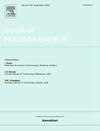Investigation of environmental effects from the operation of a nuclear power plant
IF 2.3
3区 工程技术
Q1 NUCLEAR SCIENCE & TECHNOLOGY
引用次数: 0
Abstract
This study presents a comparative analysis of pre-operational data report (July 1979–October 1980), operational data report (2010 and 2021), and sediment samples collected in September 2022, to monitor the area designated for the disposal of cooling effluents from the Angra I and II reactors, known as Piraquara de Fora, and to assess its potential environmental impacts. The activity concentrations of 134Cs, 137Cs, 58Co, 60Co, 54Mn, 7Be, 214Pb, 228Ac, and 40K were analyzed by gamma spectrometry in dry sediment samples obtained from eight distinct sampling points within the Piraquara de Fora impact area. The results of comparisons with pre-operational (1979/1980), operational (2010 and 2021), and current experimental data from 2022 indicated an increase in 40K concentrations, which can be attributed to the high background radiation levels of the region, posing no discernible threat to human or environmental well-being. These findings provide a foundation for future investigations and offer valuable insights for radiological mapping purposes.
核电站运行对环境影响的调查
本研究对运行前数据报告(1979年7月至1980年10月)、运行数据报告(2010年和2021年)和2022年9月收集的沉积物样本进行了比较分析,以监测指定用于处置安格拉1号和2号反应堆(称为Piraquara de Fora)冷却废水的区域,并评估其潜在的环境影响。采用伽马能谱法分析了Piraquara de Fora撞击区内8个不同采样点的干沉积物样品中134Cs、137Cs、58Co、60Co、54Mn、7Be、214Pb、228Ac和40K的活度浓度。与运行前(1979/1980年)、运行期间(2010年和2021年)以及2022年以来的当前实验数据进行比较的结果表明,40K浓度有所增加,这可归因于该地区的高背景辐射水平,对人类或环境福祉不构成明显的威胁。这些发现为未来的研究提供了基础,并为放射测绘目的提供了有价值的见解。
本文章由计算机程序翻译,如有差异,请以英文原文为准。
求助全文
约1分钟内获得全文
求助全文
来源期刊

Annals of Nuclear Energy
工程技术-核科学技术
CiteScore
4.30
自引率
21.10%
发文量
632
审稿时长
7.3 months
期刊介绍:
Annals of Nuclear Energy provides an international medium for the communication of original research, ideas and developments in all areas of the field of nuclear energy science and technology. Its scope embraces nuclear fuel reserves, fuel cycles and cost, materials, processing, system and component technology (fission only), design and optimization, direct conversion of nuclear energy sources, environmental control, reactor physics, heat transfer and fluid dynamics, structural analysis, fuel management, future developments, nuclear fuel and safety, nuclear aerosol, neutron physics, computer technology (both software and hardware), risk assessment, radioactive waste disposal and reactor thermal hydraulics. Papers submitted to Annals need to demonstrate a clear link to nuclear power generation/nuclear engineering. Papers which deal with pure nuclear physics, pure health physics, imaging, or attenuation and shielding properties of concretes and various geological materials are not within the scope of the journal. Also, papers that deal with policy or economics are not within the scope of the journal.
 求助内容:
求助内容: 应助结果提醒方式:
应助结果提醒方式:


